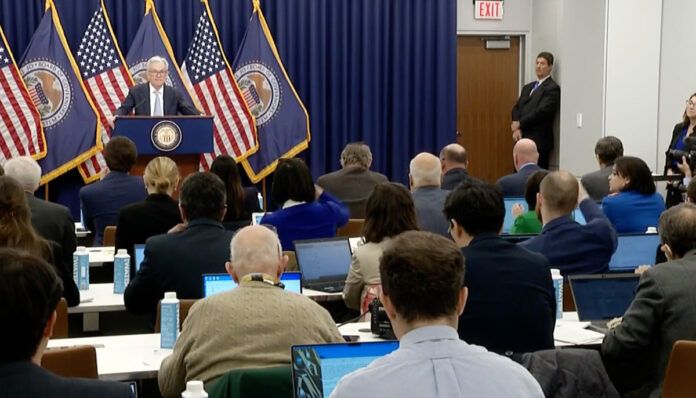
The Federal Reserve meeting for concludes May 3 with another rate hike, up 0.25 points, as many analysts and market watchers anticipated.
The central banks are keeping an eye on inflation, which has come down from a peak of 9 percent to about 4 percent. Still, there is concern about a recession.
Fed Chairman Jerome Powell said in his post-meeting press conference that the financial sector is “broadly improved” from early March, and that “It will take time for monetary restraint to be realized.”
“We at the Fed will do everything we can to achieve our workforce and monetary goals,” he said.
The Fed’s goal in raising rates is to pinch spending, slow the infusion of cash in the economy, and create what they term a “soft landing” with inflation down to an ideal 2 percent, avoiding recession. Some analysts had anticipated a stay in interest rates, which tops 5 percent with the latest move, given the recent collapse of three major lending institutions.
Silicon Valley Bank was rescued from failure by the FDIC on March 10, and New York regulators stepped in on Signature Bank two days later. The most recent failure, of First Republic Bank in late April, resulted in its sale to JP Morgan Chase.
“Our government invited us and others to step up, and we did,” JPMorgan Chase CEO Jamie Dimon said in a statement. “This acquisition modestly benefits our company overall, it is accretive to shareholders, it helps further advance our wealth strategy, and it is complementary to our existing franchise.”
More regional bank stocks took a hit in early week trading, including PacWest Bancorp and Western Alliance Bancorp. Both institutions were halted for brief times amid volatile conditions, but have rebounded well in anticipation of the Fed’s move.
The FOMC in a statement following the meeting, noted “In determining the extent to which additional policy firming may be appropriate to return inflation to 2 percent over time, the Committee will take into account the cumulative tightening of monetary policy, the lags with which monetary policy affects economic activity and inflation, and economic and financial developments. In addition, the Committee will continue reducing its holdings of Treasury securities and agency debt and agency mortgage-backed securities, as described in its previously announced plans.”
The impact of increased borrowing costs is becoming evident. In March, the unemployment rate in the United States was 3.5 percent. However, new data released on May 2 shows that job openings that month fell to their lowest level since May 2021, and layoffs rose to the highest level since December 2020 by nearly 250,000 to reach 1.8 million.
Add to that the ongoing debt ceiling negotiations between the White House, Congress, and policymakers, which surely is a matter on the minds of the central banks. Powell said there was discussion about the debt ceiling during FOCM meetings, with the realization that the Fed runs independently of administration and lawmakers and has no impact on any outcome on the Capitol.
First Trust Advisors Chief Economist Brian Wesbury said, in part, in a newsletter to subscribers “We think inflation will remain more elevated than the Fed projects and that the Fed will likely raise rates at least one more time this cycle. In addition, we believe the process for starting rate cuts is further off than the futures market suggests. Chairman Powell himself, at the post-meeting press conference, poured cold water on the prospects of rate cuts, assuming the economy develops as the Fed expects.”
MHInsider is the leader in manufactured housing news and is a product of MHVillage, the top marketplace for mobile and manufactured homes.












